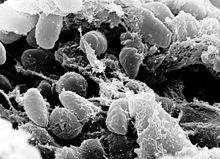Pneumonic plague

Pneumonic plague is one of three main forms of plague, all of which are caused by the bacterium Yersinia pestis. It is more virulent and rarer than bubonic plague. The difference between the versions of plague is simply the location of the infection. Pneumonic plague is an infection in the lung(s), bubonic plague is an infection of the buboes or lymph nodes, while septicemic plague is an infection in the blood stream.
Typically, pneumonic form is due to a secondary spread from advanced infection of an initial bubonic form. Primary pneumonic plague results from inhalation of fine infective droplets and can be transmitted from human to human without involvement of fleas or animals. Untreated pneumonic plague has a very high fatality rate.
Epidemiology
Since 2002, the World Health Organization (WHO) has reported six plague outbreaks, though some may go unreported because they often happen in remote areas. Between 1998 and 2009, nearly 24,000 cases have been reported, including about 2,000 deaths, in Africa, Asia, the Americas and Eastern Europe. The vast majority of the world's cases (98%) are in Africa.
Pathology and transmission
Pneumonic plague can be caused in two ways: primary, which results from the inhalation of aerosolised plague bacteria, or secondary, when septicemic plague spreads into lung tissue from the bloodstream. Pneumonic plague is not exclusively vector-borne like bubonic plague; instead it can be spread from person to person. There have been cases of pneumonic plague resulting from the dissection or handling of contaminated animal tissue. This is one type of the formerly known Black Plague. It could kill 90%–100% of a population if the victims coughed and passed on the bacteria.h
Symptoms
The most apparent symptom of pneumonic plague is coughing, often with hemoptysis (coughing up blood). With pneumonic plague, the first signs of illness are fever, headache, weakness, and rapidly developing pneumonia with shortness of breath, chest pain, cough, and sometimes bloody or watery sputum.[1] The pneumonia progresses for two to four days and may cause respiratory failure and shock. Without early treatment, patients will die, some within 24 hours.
When they begin, pneumonic plague symptoms can often include:
Rapidly developing pneumonia with:
- Shortness of breath
- Chest pain
- Cough
- Bloody or watery sputum (saliva and discharge from respiratory passages).[2]
Prognosis and treatment
Pneumonic plague is a very aggressive infection requiring early treatment. To reduce the risk of death, antibiotics must be given within 24 hours of first symptoms.[1] Streptomycin, gentamicin, tetracyclines, and chloramphenicol are all effective against pneumonic plague.
Antibiotic treatment for seven days will protect people who have had direct, close contact with infected patients. Wearing a close-fitting surgical mask also protects against infection.[1]
Without treatment, the mortality rate from pneumonic plague approaches 100%.[3]
China
The People's Republic of China has eradicated the pneumonic plague from most parts of the country, but still reports occasional cases in remote Western areas where the disease is carried by rats and the marmots that live across the Himalayan plateau. Outbreaks can be caused when a person eats an infected marmot or comes into contact with fleas carried by rats. A 2006 WHO report from an international meeting on plague cited a Chinese government disease expert as saying that most cases of the plague in China's northwest occur when hunters are contaminated while skinning infected animals.[4] The expert said at the time that due to the region's remoteness, the disease killed more than half the infected people. The report also said that since the 1990s, there was a rise in plague cases in humans—from fewer than 10 in the 1980s to nearly 100 cases in 1996 and 254 in 2000.[5] Official statistics posted on the Chinese Health Ministry's Web site showed no cases of plague in 2007 and 2008.[citation needed] In September 2008, two persons in east Tibet died of pneumonic plague.[6]
A recent outbreak of the disease in China began in August 2009 in Ziketan Town located in Qinghai Province and is an ongoing situation. The town has been sealed off and so far three people have died as a result of the disease.[4][7] According to spokesperson Vivian Tan of the WHO office in Beijing, "In cases like this [in August 2009], we encourage the authorities to identify cases, to investigate any suspicious symptoms among close contacts and to treat confirmed cases as soon as possible. So far, they have done exactly that. There have been sporadic cases reported around the country in the last few years so the authorities do have the experience to deal with this."[8]
Recent Notable Cases
On November 7, 2007, wildlife biologist Eric York died of pneumonic plauge in Grand Canyon National Park. York was exposed to the bacteria while conducting a necropsy on a mountain lion carcass.[9]
See also
References
- ^ a b c Facts about Pneumonic Plague (Center for Disease Control, 2004)
- ^ Pneumonic Plague Symptoms. Nhatky. August 3, 2009.
- ^ Plague. (Iowa State University, 2004)
- ^ a b "China disinfects town where plague killed 3rd man". The Associated Press. 2009-08-04.
- ^ Macartney, Jane (August 3, 2009). Entire town in quarantine after two die from pneumonic plague in China. The Times.
- ^ Two deaths from rare, deadly plague in Tibet
- ^ "4th plague patient near death in NW China province". Xinhua. 2009-08-05.
- ^ Alert over China plague outbreak. Al Jazeera. August 3, 2009.
- ^ Plague emerges in Grand Canyon, kills biologist
External links
- Facts about Pneumonic Plague. Centers for Disease Control and Prevention.
